Mongolian Ground Force
The Ground Force of Mongolia (Mongolian: Монгол Улсын Зэвсэгт хүчний Хуурай замын цэрэг, Mongol Ulsyn Zevsegt hüchniy Huurai zamyn tsereg, lit. 'Mongolian Land Force of the Armed Forces') is the land force of the Mongolian Armed Forces, formed from parts of the former Mongolian People's Army in 1992. It was known as the "Mongolian General Purpose Force" (Mongolian: Монгол Улсын Ерөнхий Цэргийн Хүчин) until 2016.
| Mongolian Ground Force | |
|---|---|
| Монгол Улсын Зэвсэгт хүчний Хуурай замын цэрэг | |
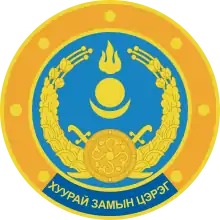 The Mongolian Ground Force's emblem | |
| Founded | 1921 |
| Country | |
| Type | Army |
| Size | 39,000 active personnel[1] |
| Part of | |
| March | "The Red Banner March" (Тугийн марш/Tugiin Marsh) |
| Engagements | Mongolian Revolution of 1921 Soviet-Japanese Border War Soviet invasion of Manchuria Battle of Baitag Bogd |
| Commanders | |
| Commander | Brigadier General B. Amgalanbaatar |
| Chief of Staff | Brigadier General L.Ontsgoibayar[2] |
| Insignia | |
| Flag | 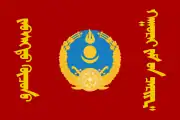 |
History
At present Mongolia's armed forces have become more compact and professional since obligatory military service was replaced with the alternative between military and other service. The ground force, a core of the armed forces, are the main force to defend the country by military means. In peacetime, the ground force direct their activities toward ensuring the mobilization readiness of the Mongolian Armed Forces, providing military training for the population, forming personnel resources, and organizing the maintenance, protection and servicing of military equipment and material reserves. Depending on the organizational specifics of military units and organizations, the ground force are divided into combat, on-combat-duty, training, training combat, and stockpile and service units.
As a result of reform processes started in 1997, units of the Mongolian Armed Forces were reorganized into a brigade-battalion system. In peacetime, sub-units of brigades have a mixed personnel organization (i.e. of constant combat readiness, training, and under strength). In 2016, the General Purpose Force was renamed to its current name of Ground Force of the Armed Forces. In 1997 the Mongolian Armed Forces had in service 650 tanks, 120 light armored reconnaissance vehicles, 400 armored infantry fighting vehicles, 300 armored personnel carriers, 300 towed artillery, 130 multiple rocket launchers, 140 mortars, and 200 anti-tank guns. Mongolia deployed its troops to peacekeeping operations in Iraq and Afghanistan with 1970s Soviet-bloc weapons, transportation, and equipment. Although Mongolian troops are highly skilled with using these weapons and equipment, they are not interoperable with the rest of the coalition members. Except for the United States-provided Harris Corporation communications equipment, Mongolia had no other equipment which was interoperable. From January 14 to 18 in 2008, Chief of the General Staff of the MAF Lieutenant General Tsevegsuren Togoo signed an agreement for acquisition of equipment and vehicles from Russia for 120 million US dollars during his official visit to Moscow, Russia.
Structure
- 013th Military Unit[3]
- 014th Construction Unit
- 016th Mechanised Brigade (stationed at Sergelen near Ulaanbaatar),[4] it has been reported as the oldest formation of the Mongolian Army.
- 017th Construction Regiment
- 029th Military Unit
- 032nd Military Unit
- 084th Special Task Battalion[5][6]
- 110th Military Unit (based in the Orkhon Province)[7]
- 119th Military Unit
- 150th Peacekeeping Battalion
- 186th Military Unit (based in the Orkhon Province)[7]
- 331st Special Battalion
- 337th Military Unit (based in Nalaikh)
- 339th Construction Unit (based in the Bayankhongor Province)[8]
- 350th Military Unit
Peacekeeping missions
.jpg.webp)
Mongolian armed forces are performing peacekeeping missions in South Sudan, Sierra Leone, Ethiopia, Congo, Eritrea, Western Sahara, and Afghanistan, and with the United Nations Mission in Liberia. In 2005 and 2006, Mongolian troops also served as part of the Belgian KFOR contingent in Kosovo. From 2009 the Mongolian Armed Forces deploying its largest peace keeping mission to Chad and the government is planning to deploy its first fully self-sufficient UN mission there in mid-2011.
Equipment
The Ground Force possesses over 470 tanks, 650 infantry fighting vehicles and armored personnel carriers, 500 mobile anti-aircraft weapons, more than 700 artillery and mortar and other military equipment. Most of them are old Soviet Union-made models designed between the late 1950s to early 1980s; there are a smaller number of newer models designed in post-Soviet Russia.
Infantry weapons
Gallery
 Mongolian soldiers salute while the Mongolian flag waves at the Transit Center at Manas, where they stayed for several days before moving forward to Afghanistan to support Operation Enduring Freedom.
Mongolian soldiers salute while the Mongolian flag waves at the Transit Center at Manas, where they stayed for several days before moving forward to Afghanistan to support Operation Enduring Freedom..jpg.webp) Members of the Mongolian Expeditionary Task Force 1 stand in formation for Mongolian Army Day at Camp Eggers, Afghanistan. Mongolian Army Day is an annual event that has occurred since 1921.
Members of the Mongolian Expeditionary Task Force 1 stand in formation for Mongolian Army Day at Camp Eggers, Afghanistan. Mongolian Army Day is an annual event that has occurred since 1921.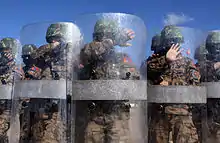 Members of the Mongolian Armed Forces and Internal Forces practice crowd control techniques as a part of Non-Lethal Weapons Executive Seminar 2010 at 5 Hills Training Facility, Mongolia, June 2010.
Members of the Mongolian Armed Forces and Internal Forces practice crowd control techniques as a part of Non-Lethal Weapons Executive Seminar 2010 at 5 Hills Training Facility, Mongolia, June 2010. Mongolian Powerstar truck in Mongolian military service.
Mongolian Powerstar truck in Mongolian military service. An honor guard salutes during the welcoming ceremonies for Air Force General Richard B. Myers, who became the first Chairman of the Joint Chiefs of Staff to visit Mongolia, January 2004.
An honor guard salutes during the welcoming ceremonies for Air Force General Richard B. Myers, who became the first Chairman of the Joint Chiefs of Staff to visit Mongolia, January 2004. A Mongolian soldier performs during the opening ceremony for exercise Khaan Quest 2013 at the Five Hills Training Area in Mongolia, August 2013.
A Mongolian soldier performs during the opening ceremony for exercise Khaan Quest 2013 at the Five Hills Training Area in Mongolia, August 2013.
References
- The Military Balance 2013
- https://www.gsmaf.gov.mn/hztsk/commander
- "Зэвсэгт хүчний 013 дугаар ангийг Цэргийн гавьяаны улаан тугийн одонгоор шагналаа". Монгол Улсын Ерөнхийлөгчийн Тамгын Газар. 2019-10-14. Retrieved 2021-01-01.
- "The Mongolian army was T-72 tanks and BTR-70M". Encyclopedia of safety. Retrieved June 20, 2016.
- "Ambassador Jennifer Zimdahl Galt's Remarks at Balance Magic Closing Ceremony". U.S. Embassy in Mongolia. 2017-10-02. Retrieved 2020-12-31.
- "India commences joint military exercise 'Nomadic Elephant' with Mongolia | Headlines". Devdiscourse. Retrieved 2020-12-31.
- "ЗЭВСЭГТ ХҮЧНИЙ 186, 110-Р АНГИД ХУГАЦААТ ЦЭРГИЙН АЛБА ХААЖ БУЙ ДАЙЧИД ТАНГАРАГ ӨРГӨЛӨӨ". www.erdenet.mn. Retrieved 2021-01-01.
- The Military Balance 2012, p.267.
- "SIPRI Arms Transfers Database". Stockholm International Peace Research Institute. Retrieved June 20, 2016.
- "Trade Registers". armstrade.sipri.org. Retrieved 2020-09-15.
- "БХ-ын сайд тайлангаа тавив". News.mn (in Mongolian). May 3, 2011. Retrieved June 20, 2016.
- Jones, Richard D., ed. (January 27, 2009). Jane's Infantry Weapons 2009/2010 (35th ed.). Jane's Information Group. ISBN 978-0-7106-2869-5.
- "084.jpg". ImageShack.us. Retrieved June 20, 2016.
- Тусгай Хүчин (December 28, 2013). "Mongolian 084th Special Task Battalion". Retrieved June 20, 2016 – via YouTube.
- name="jones2009">Jones, Richard D., ed. (January 27, 2009). Jane's Infantry Weapons 2009/2010 (35th ed.). Jane's Information Group. ISBN 978-0-7106-2869-5.
- "Untitled JPEG". U.S Department of Defense. January 2004. Archived from the original on October 11, 2014. Retrieved 20 June 2016.
- "SVD rifles in use in Europe". Dragunov.net. Archived from the original on November 9, 2012. Retrieved June 20, 2016.
- "Untitled JPEG". ImageShack.us. Archived from the original on July 2, 2014. Retrieved June 20, 2016.
 This article incorporates public domain material from the CIA World Factbook website https://www.cia.gov/the-world-factbook/.
This article incorporates public domain material from the CIA World Factbook website https://www.cia.gov/the-world-factbook/.- World aircraft information files Bright Star Publishing London File 332 Sheet 3
External links
| Wikimedia Commons has media related to Military of Mongolia. |
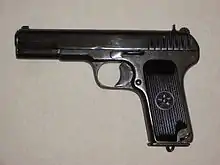
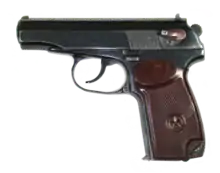
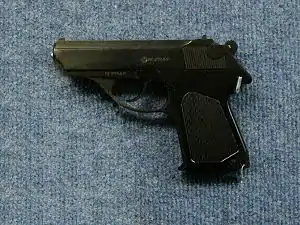






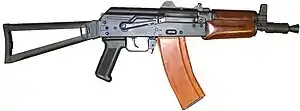

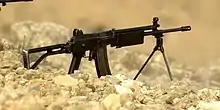
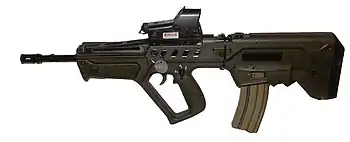
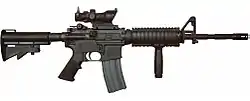
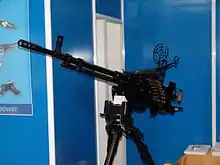
.JPG.webp)






